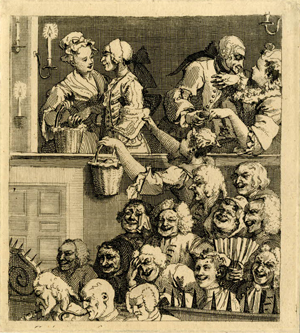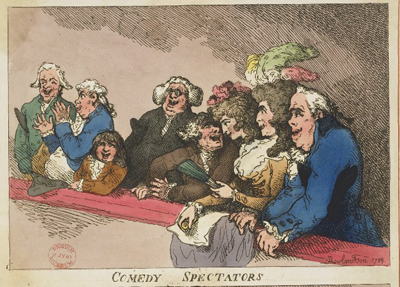Characters | Caricaturas
Hogarth first responded to the growing popularity of caricature in Characters | Caricaturas in 1743. The print was prompted by the publication of a collection of 25 caricatures by Ghezzi, Carracci, Marratti, and others etched and printed by Arthur Pond between 1736 and 1743 and including the Ghezzi portrait of Thomas Bentley shown elsewhere on this site.

Characters | Caricaturas [1743]
© Trustees of the British Museum
Supported by Henry Fielding in the Preface to Joseph Andrews, Hogarth and Fielding make the case that the comic history painting of Hogarth consists in the "exactest copying of nature" whereas caricatura aims to create "Monsters not Men; and all Distortions and Exaggerations are within its proper Province."
Looking at the evidence of prints like Scholars at a Lecture [1736], A Midnight Modern Conversation, The Laughing Audience and many other prints that proved seminal for later caricaturists, most disinterested observers would agree that Hogarth failed miserably in his attempt to draw a clear distinction between his work and caricature as we know it today. But when we look at caricature as Hogarth saw it in 1743, at the caricatures included in the Pond collection, I think we can see the real basis of Hogarth's objection. Apart from their foreign origin which made them anathema to the sturdy Englishman, Hogarth, the Pond caricatures are fundamentally flat, static, and undramatic, indeed wholly lacking in the exuberant life and vitality (the character) of Hogarth's work.
What Hogarth couldn't have realized is that caricature was only just beginning to evolve. And at the hands of Bunbury, Rowlandson, and Gillray, it would become a worthy successor of Hogarth in accurately expressing the full range of the passions of everyday life.

Laughing Audience [1733]
© Trustees of the British Museum

Comedy Spectators [1789]
© Trustees of the British Museum